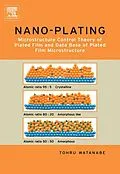Modern plating technology is highly advanced, and has developed to cover a wide range of applications. In addition to the traditional use for surface finishing, plating technology can now offer novel processes to fabricate high-performance films or fine microstructural bodies in the microelectronics industry. This rapid progress reflects the potential for the electroplating plating method to become one of today's leading-edge technologies. This book will introduce a concept of a Microstructure Control Theory for plated films, describe and discuss various experimental results that support the theory, and finally, present a collection of experimental data on 53 types of plated metal/alloy systems with a special emphasis on their microstructure.The unique feature of this database is that most of the plating baths are simple and contain no additives. In addition, amorphous materials were used as substrates to avoid the effects of substrate structure, and single-crystal substrates were chosen to study the epitaxial growth phenomenon.
* Contains a comprehensive database for the microstructure of plated films
* The book is very logically structured with a very detailed contents which makes finding information easy
* The book gives a very good overview of the research and development in this field and each chapter is fully referenced
Autorentext
For many years, Tohru Watanabe worked in the Department of Applied Chemistry at Tokyo Metropolitan University. He is currently engaged in electrochemical engineering and technical consulting at the Watanabe Nano-Plating Laboratory. He organized the Nano plating Study Group and held 134 study sessions in 33 years and continues to do so. He is the author of Nano-Plating, published by Elsevier in 2004, and published many articles and several conference papers in international scientific journals, as well as several Japanese books.
Tohru Watanabe graduated from Shibaura Institute of Technology. After researching on mechanical materials in the Department of Mechanical Engineering at Tokyo Metropolitan University, he moved to the Department of Industrial Chemistry and started research on plating from there. In 1976 be obtained a doctoral degree in Engineering from Tokyo Metropolitan University. Then he was a visiting researcher at University of Sussex in the UK, a visiting professor at Beijing Institute of Technology, a lecturer at Shibaura Institute of Technology, and Chuo University, and a researcher at the Tokyo Metropolitan Industrial Research Center.
Inhalt
Fine Plating, Microstructure Control and Measurements for Plated Films; Research Process of Plating Technology; Review of Previous TMC and Practical Plated Films; Theory of Microstructure Control For Plated Films; Film Formation Mechanism In Electrodeposition; Plating In Organic Electrolyte; Experimental Methods; Selection of Plating Electrolyte; Cobalt Deposition from various Organic Solvent Solutions; Formation of Electrolytic Films; Electroless Films; Microstructural Changes in Plated Films during Heat Treatment; A Change of Meta-Stable and Non-Equilibrium Phases to Stable Crystals; Transformation of Amorphous Phase to Equilibrium Phase; Macrostructure Control in Plated Films; Fabrication of 3-D Microstructural Body; Characterization Methods for Plated Films; Structure of Metal Substrates; Structural Determination of Plated Films; Grain Size Measurements; Observations of Surface Morphology; Measurement of Preferred Orientation; Plating Methods; Microstructure Observations and Measurements Methods For Plated Films; Data Base on the Microstructure of Plated Films
